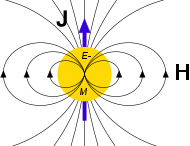List of equations in gravitation
This article summarizes equations in the theory of gravitation.
Definitions
Gravitational mass and inertia
A common misconception occurs between centre of mass and centre of gravity. They are defined in similar ways but are not exactly the same quantity. Centre of mass is the mathematical description of placing all the mass in the region considered to one position, centre of gravity is a real physical quantity, the point of a body where the gravitational force acts. They are equal if and only if the external gravitational field is uniform.
Quantity (common name/s) (Common) symbol/s Defining equation SI units Dimension Centre of gravity rcog (symbols vary) ith moment of mass Centre of gravity for a set of discrete masses:
Centre of gravity for a continuum of mass:
m [L] Standard gravitational parameter of a mass μ N m2 kg−1 [L]3 [T]−2
Newtonian gravitation
.svg.png)

Quantity (common name/s) (Common) symbol/s Defining equation SI units Dimension Gravitational field, field strength, potential gradient, acceleration g N kg−1 = m s−2 [L][T]−2 Gravitational flux ΦG m3 s−2 [L]3[T]−2 Absolute gravitational potential Φ, φ, U, V J kg−1 [L]2[T]−2 Gravitational potential difference ΔΦ, Δφ, ΔU, ΔV J kg−1 [L]2[T]−2 Gravitational potential energy Ep J [M][L]2[T]−2 Gravitational torsion field Ω Hz = s−1 [T]−1
Gravitoelectromagnetism
In the weak-field and slow motion limit of general relativity, the phenomenon of gravitoelectromagnetism (in short "GEM") occurs, creating a parallel between gravitation and electromagnetism. The gravitational field is the analogue of the electric field, while the gravitomagnetic field, which results from circulations of masses due to their angular momentum, is the analogue of the magnetic field.
Quantity (common name/s) (Common) symbol/s Defining equation SI units Dimension Gravitational torsion flux ΦΩ N m s kg−1 = m2 s−1 [M]2 [T]−1 Gravitomagnetic field H, Bg, B, ξ Hz = s−1 [T]−1 Gravitomagnetic flux Φξ N m s kg−1 = m2 s−1 [M]2 [T]−1 Gravitomagnetic vector potential [1] h m s−1 [M] [T]−1
Equations
Newtonian gravitational fields
It can be shown that a uniform spherically symmetric mass distribution generates an equivalent gravitational field to a point mass, so all formulae for point masses apply to bodies which can be modelled in this way.
Physical situation Nomenclature Equations Gravitational potential gradient and field - U = gravitational potential
- C = curved path traversed by a mass in the field
Point mass At a point in a local array of point masses Gravitational torque and potential energy due to non-uniform fields and mass moments - V = volume of space occupied by the mass distribution
- m = mr is the mass moment of a massive particle
Gravitational field for a rotating body - = zenith angle relative to rotation axis
- = unit vector perpendicular to rotation (zenith) axis, radial from it
Gravitational potentials
General classical equations.
Physical situation Nomenclature Equations Potential energy from gravity, integral from Newton's law Escape speed - M = Mass of body (e.g. planet) to escape from
- r = radius of body
Orbital energy - m = mass of orbiting body (e.g. planet)
- M = mass of central body (e.g. star)
- ω = angular velocity of orbiting mass
- r = separation between centres of mass
- T = kinetic energy
- U = gravitational potential energy (sometimes called "gravitational binding energy" for this instance)
Weak-field relativistic equations
Physical situation Nomenclature Equations Gravitomagnetic field for a rotating body - ξ = gravitomagnetic field
See also
- Defining equation (physical chemistry)
- Defining equation (physics)
- List of electromagnetism equations
- List of equations in classical mechanics
- List of equations in nuclear and particle physics
- List of equations in quantum mechanics
- List of equations in wave theory
- List of photonics equations
- List of relativistic equations
- Table of thermodynamic equations
Footnotes
- Gravitation and Inertia, I. Ciufolini and J.A. Wheeler, Princeton Physics Series, 1995, ISBN 0-691-03323-4
Sources
- P.M. Whelan, M.J. Hodgeson (1978). Essential Principles of Physics (2nd ed.). John Murray. ISBN 0-7195-3382-1.
- G. Woan (2010). The Cambridge Handbook of Physics Formulas. Cambridge University Press. ISBN 978-0-521-57507-2.
- A. Halpern (1988). 3000 Solved Problems in Physics, Schaum Series. Mc Graw Hill. ISBN 978-0-07-025734-4.
- R.G. Lerner, G.L. Trigg (2005). Encyclopaedia of Physics (2nd ed.). VHC Publishers, Hans Warlimont, Springer. pp. 12–13. ISBN 978-0-07-025734-4.
- C.B. Parker (1994). McGraw Hill Encyclopaedia of Physics (2nd ed.). McGraw Hill. ISBN 0-07-051400-3.
- P.A. Tipler, G. Mosca (2008). Physics for Scientists and Engineers: With Modern Physics (6th ed.). W.H. Freeman and Co. ISBN 978-1-4292-0265-7.
- L.N. Hand, J.D. Finch (2008). Analytical Mechanics. Cambridge University Press. ISBN 978-0-521-57572-0.
- T.B. Arkill, C.J. Millar (1974). Mechanics, Vibrations and Waves. John Murray. ISBN 0-7195-2882-8.
- J.R. Forshaw, A.G. Smith (2009). Dynamics and Relativity. Wiley. ISBN 978-0-470-01460-8.
Further reading
- L.H. Greenberg (1978). Physics with Modern Applications. Holt-Saunders International W.B. Saunders and Co. ISBN 0-7216-4247-0.
- J.B. Marion, W.F. Hornyak (1984). Principles of Physics. Holt-Saunders International Saunders College. ISBN 4-8337-0195-2.
- A. Beiser (1987). Concepts of Modern Physics (4th ed.). McGraw-Hill (International). ISBN 0-07-100144-1.
- H.D. Young, R.A. Freedman (2008). University Physics – With Modern Physics (12th ed.). Addison-Wesley (Pearson International). ISBN 0-321-50130-6.
